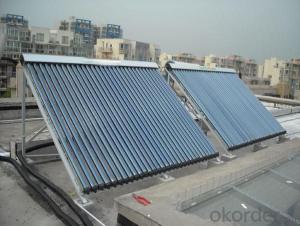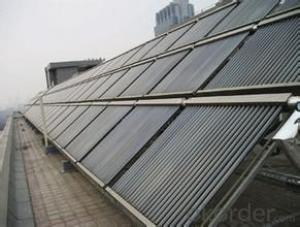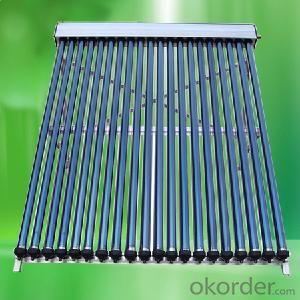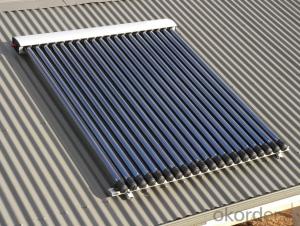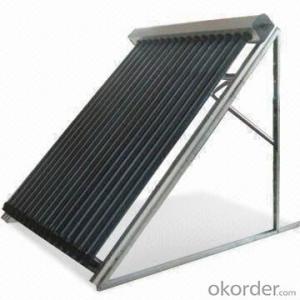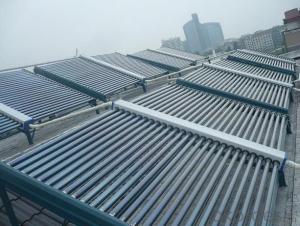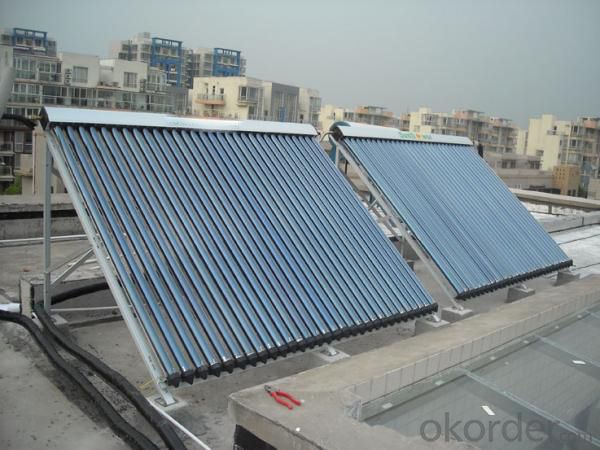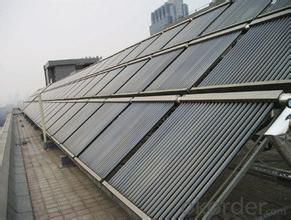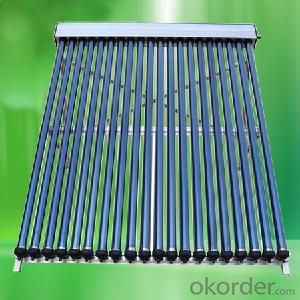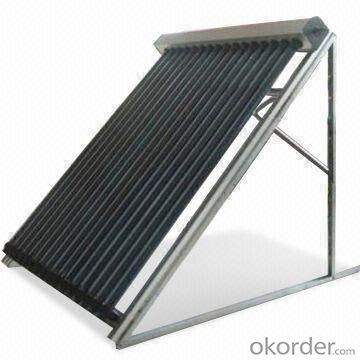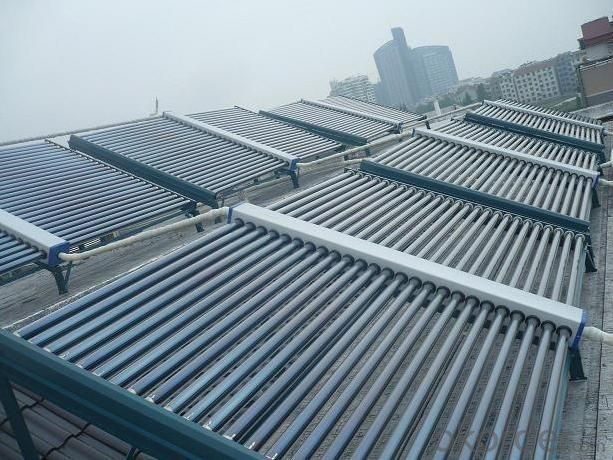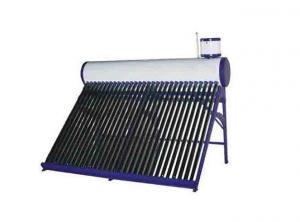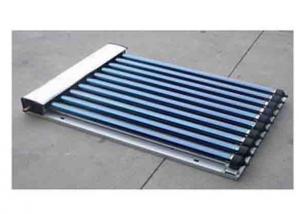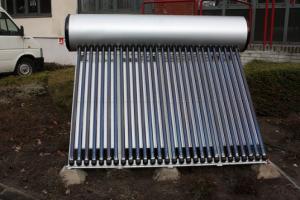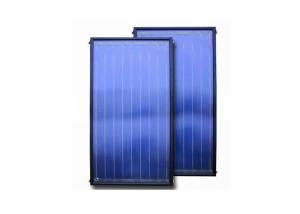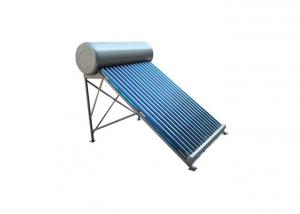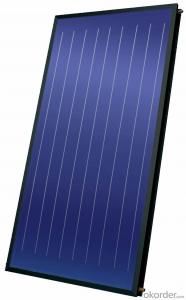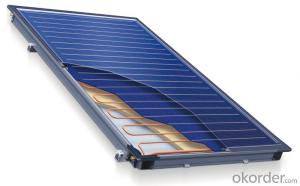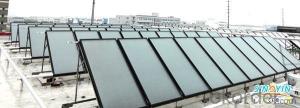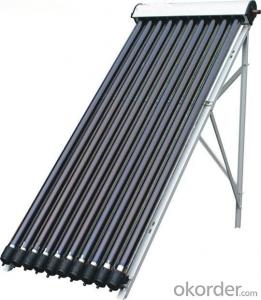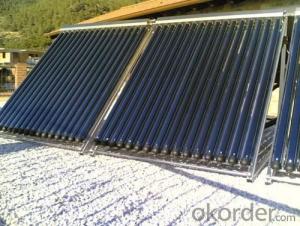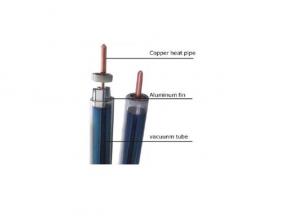Pearson Solar Collectors - Heat Pipe Vacuum Tubes with Certificate
- Loading Port:
- China main port
- Payment Terms:
- TT OR LC
- Min Order Qty:
- 5 set
- Supply Capability:
- 10000 set/month
OKorder Service Pledge
OKorder Financial Service
You Might Also Like
Specifications
manifold (inner) | red copper |
manifold (exterior) | aluminum alloy |
glass tube dimensions | 58mm * 1800mm |
daily efficiency | ≥55% |
heat preservation | 72 hours |
hail resistance | 25mm |
max pressure | 7 bar |
coating of vacuum tube | ALN/AIN-SS/CU |
heat pipe | anti-freezing > -35 degree |
certificate | Solar Keymark, EN12975,SRCC |
Serious Product
Models | L*W*H mm | Vacuum tube | Power output | Efficiency | Header mm | Frame | container loading 20FT/40HQ sets | Gross Weight kg |
SHC-8 | 1917*910*133 | 58*1800*8pcs | 939W | 0.668 | Φ35/1.0 | AL alloy | 185/445 | 27 |
SHC-10 | 1917*1130*133 | 58*1800*10pcs | 1189W | 159/385 | 33 | |||
SHC-12 | 1917*1350*133 | 58*1800*12pcs | 1440W | 149/358 | 40 | |||
SHC-15 | 1917*1680*133 | 58*1800*15pcs | 1815W | 120/290 | 49 | |||
SHC-18 | 1917*2010*133 | 58*1800*18pcs | 2191W | 100/242 | 59 | |||
SHC-20 | 1917*2230*133 | 58*1800*20pcs | 2442W | 87/210 | 66 | |||
SHC-22 | 1917*2450*133 | 58*1800*22pcs | 2692W | 83/202 | 72 | |||
SHC-24 | 1917*2670*133 | 58*1800*24pcs | 2943W | 77/188 | 79 |
Packaging & Delivery
Packaging Details: | Exporting Carton with big foaming protection |
Delivery Detail: | In 10-15 days |
Loading Quantity
Model | Tube | Tube Q.T.Y | Loading Q.T.Y/40HQ |
GSC15 | 58*1800mm | 15pcs | 315sets |
GSC18 | 58*1800mm | 18pcs | 265sets |
GSC20 | 58*1800mm | 20pcs | 248sets |
GSC22 | 58*1800mm | 22pcs | 225sets |
GSC25 | 58*1800mm | 25pcs | 200sets |
GSC30 | 58*1800mm | 30pcs | 168sets |
Principle of solar collector:
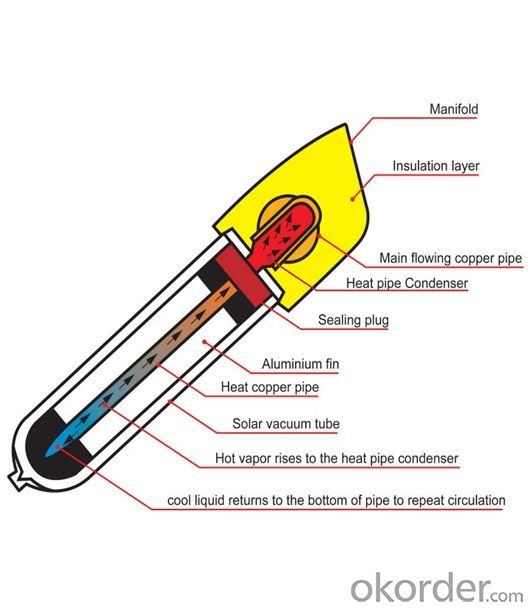
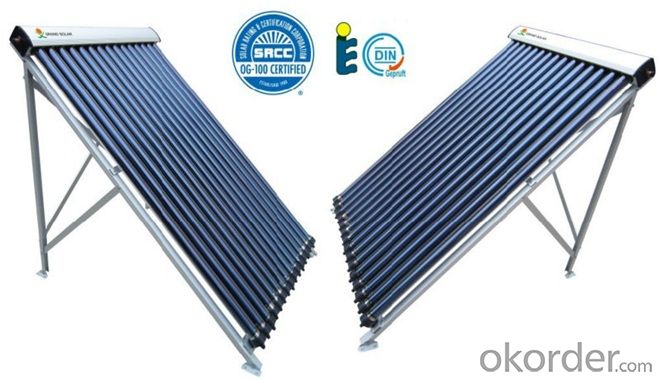
Solar collector details
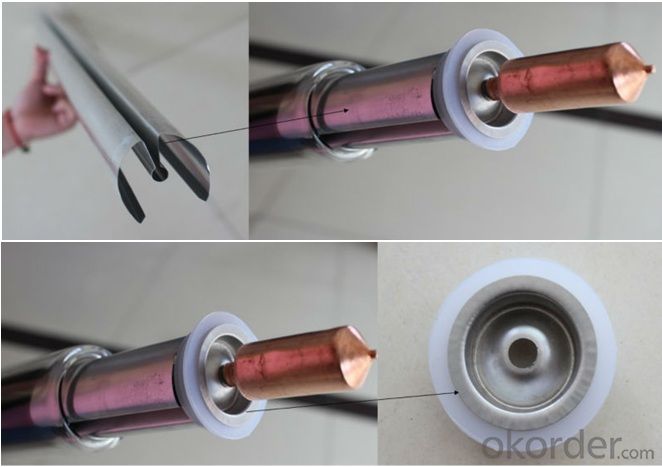
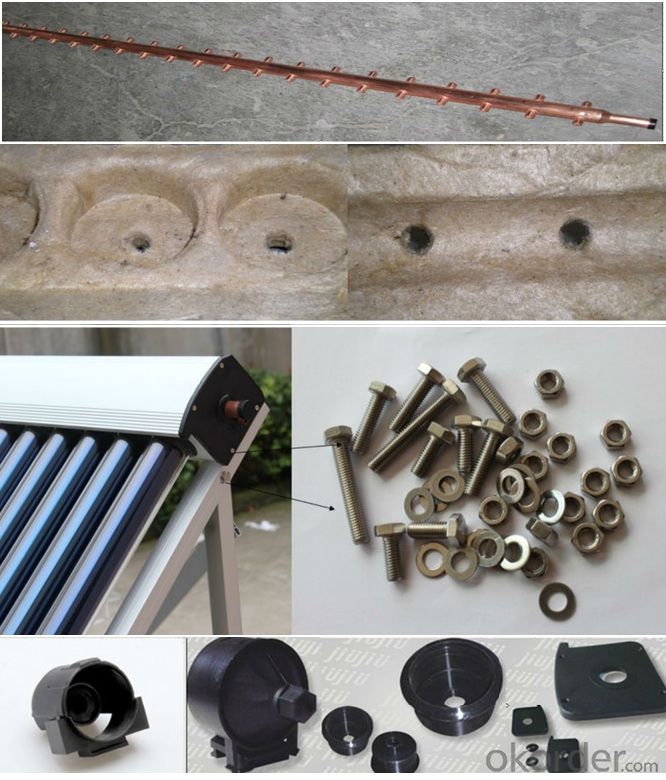
- Q: Can solar collectors be used in solar thermal drying?
- Indeed, solar thermal drying can utilize solar collectors. These devices are designed to capture and convert sunlight into usable thermal energy. In the context of solar thermal drying, solar collectors can be employed to warm up air or a heat transfer fluid. This heated air or fluid is then utilized to dry agricultural products, food, or other materials. Solar thermal drying proves to be an efficient and sustainable approach to drying, as it takes advantage of the abundant and renewable energy provided by the sun. Solar collectors can be integrated into a drying system, either in the form of flat plate collectors or evacuated tube collectors, depending on specific requirements and conditions. When sunlight hits the solar collectors, it absorbs and transfers energy to the air or fluid passing through them. This heated air or fluid is then circulated through the drying chamber, where it comes into contact with the material being dried. The heat from the air or fluid aids in removing moisture from the material, resulting in the drying process. Solar thermal drying offers numerous advantages compared to conventional drying methods. Firstly, it eliminates the need for fossil fuels or electricity, thereby reducing both energy costs and carbon emissions. Secondly, it ensures a more controlled and uniform drying process, leading to improved quality and preservation of dried products. Furthermore, solar thermal drying systems can be easily integrated with existing drying infrastructure, making it a feasible option for various industries and applications. To conclude, solar collectors can indeed be utilized in solar thermal drying. They play a vital role in harnessing solar energy and delivering the necessary heat for the drying process. By utilizing solar collectors, solar thermal drying offers a sustainable and efficient alternative to conventional drying methods.
- Q: Can solar collectors be used in areas with limited maintenance capabilities?
- Yes, solar collectors can be used in areas with limited maintenance capabilities. Solar collectors are designed to be durable and require minimal maintenance. They are built to withstand harsh weather conditions and typically have no moving parts, reducing the need for regular upkeep. As long as the initial installation is done correctly and the collectors are periodically checked for any debris or damage, they can effectively operate in areas with limited maintenance capabilities.
- Q: Can solar collectors be used for heating tourist attractions and theme parks?
- Yes, solar collectors can be used for heating tourist attractions and theme parks. Solar thermal systems can be effectively utilized to heat water or air, providing a sustainable and cost-effective solution for maintaining comfortable temperatures in these locations. By harnessing solar energy, these collectors can help reduce carbon emissions and dependence on traditional heating methods, making them an environmentally friendly choice for heating tourist attractions and theme parks.
- Q: Can solar collectors be used in food processing plants?
- Yes, solar collectors can be used in food processing plants. Solar collectors, also known as solar thermal systems, can provide heat energy to various industrial processes, including food processing. These systems capture sunlight and convert it into thermal energy, which can be used to heat water, air, or other fluids. In food processing plants, solar collectors can be utilized to generate hot water for cleaning and sanitizing equipment, pasteurization, and sterilization purposes. The high temperatures required for these processes can be achieved through solar thermal systems, reducing the reliance on traditional fossil fuel-based heating methods. Furthermore, solar collectors can also be integrated with food drying systems. Solar drying is a sustainable and cost-effective method of preserving food by removing moisture content. By using solar collectors, food processing plants can harness the sun's energy to generate heat for drying operations, reducing energy costs and minimizing environmental impact. However, it is important to note that the feasibility of using solar collectors in food processing plants depends on various factors, such as the availability of sunlight, space for installation, and the specific energy requirements of the plant. Nonetheless, with advancements in solar technology and increasing focus on sustainability, solar collectors are becoming an attractive option for food processing plants aiming to reduce their carbon footprint and energy consumption.
- Q: Can solar collectors be used in geothermal power plants?
- No, solar collectors cannot be used in geothermal power plants. Geothermal power plants harness the heat energy from the Earth's interior, while solar collectors capture energy from the sun. These are two distinct and separate methods of generating power, and cannot be combined in the same facility.
- Q: How do solar collectors compare to traditional fossil fuel-based heating systems in terms of emissions?
- Solar collectors are significantly more environmentally friendly than traditional fossil fuel-based heating systems in terms of emissions. Fossil fuel-based heating systems release greenhouse gases and other pollutants into the atmosphere, contributing to climate change and air pollution. On the other hand, solar collectors harness the sun's energy, producing zero emissions during operation. This makes them a cleaner and more sustainable option for heating systems.
- Q: What is the typical installation process for solar collectors?
- The typical installation process for solar collectors involves several steps. Firstly, a site assessment is conducted to determine the suitability of the location. Factors such as the amount of sunlight received, shading from nearby structures or trees, and the structural integrity of the roof are taken into consideration. Once the site is deemed suitable, the next step is to design the solar collector system. This involves calculating the required number of collectors based on the energy needs of the property, as well as designing the mounting system and determining the optimal placement of the collectors. After the design phase, the installation of the mounting system begins. This may involve attaching brackets or framework to the roof or ground, depending on the type of collectors being installed. It is important to ensure that the mounting system is securely attached to withstand the weight of the collectors and any potential wind or snow loads. Next, the solar collectors themselves are installed onto the mounting system. This involves connecting the collectors to the mounting brackets or framework and securing them in place. Care must be taken to ensure that the collectors are properly aligned and oriented towards the sun to maximize their efficiency. Once the collectors are installed, the next step is to connect them to the property's electrical system. This typically involves installing wiring and a solar inverter, which converts the collected DC power into AC power that can be used by the property. The inverter is usually connected to the property's main electrical panel to allow for seamless integration with the existing electrical system. Finally, the installation process concludes with a thorough inspection and testing of the entire system to ensure that it is functioning properly and safely. This may involve checking the wiring connections, testing the output of the solar collectors, and verifying that all safety measures are in place. Overall, the installation process for solar collectors requires careful planning, design, and execution to ensure a successful and efficient system. It is recommended to hire a professional solar installer with experience in the field to ensure a smooth and reliable installation.
- Q: Vacuum tube for solar collectors
- Good insulation: heat pipe has a one-way heat transfer characteristics, so that hot water at night will not heat down the heat pipe to the surrounding environment.
- Q: Are solar collectors suitable for agricultural processing facilities?
- Yes, solar collectors are suitable for agricultural processing facilities. They can provide clean and sustainable energy for various operations such as drying crops, heating water, or powering machinery. Solar collectors offer cost savings on energy bills and reduce carbon emissions, making them an environmentally friendly choice for agricultural processing facilities.
- Q: Can solar collectors be used for heating airports?
- Yes, solar collectors can be used for heating airports. Solar thermal systems can be installed to capture and utilize solar energy for heating purposes, such as providing heat to buildings, hangars, or other airport facilities. These systems can effectively reduce the reliance on traditional heating methods, lower energy costs, and contribute to a more sustainable and environmentally friendly operation.
Send your message to us
Pearson Solar Collectors - Heat Pipe Vacuum Tubes with Certificate
- Loading Port:
- China main port
- Payment Terms:
- TT OR LC
- Min Order Qty:
- 5 set
- Supply Capability:
- 10000 set/month
OKorder Service Pledge
OKorder Financial Service
Similar products
Hot products
Hot Searches
Related keywords
